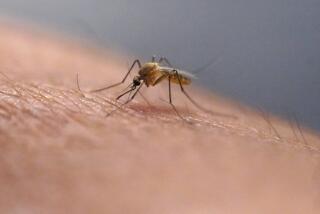The Buzz on Keeping Mosquitoes at Bay
- Share via
For such a tiny insect, the mosquito provokes much annoyance and dread, especially among travelers. Some of the 2,500-plus species not only leave an irritating and itchy bite but also transmit a host of diseases, including malaria, yellow fever, dengue fever and encephalitis.
The lowly mosquito is dubbed “our most persistent and deadly foe” by Harvard scientist Andrew Spielman and reporter Michael D’Antonio, coauthors of “Mosquito” (Hyperion, $22.95), a recently released book on the bug.
Although many mosquito-borne diseases are mainly a concern of overseas travelers, domestic travelers need to pay heed too. The West Nile virus, commonly found in Africa, Eastern Europe, West Asia and the Middle East, surfaced in the Western Hemisphere for the first time in 1999, in New York City. In 1999 and 2000, nine people in the United States died of West Nile encephalitis, the brain inflammation caused by the virus, according to the federal Centers for Disease Control and Prevention.
And the virus is spreading. It has been found (mainly in birds) in more than a dozen states, according to figures from the CDC. Last month a Florida man was hospitalized with encephalitis after being bitten by an infected mosquito. Mosquitoes become infected with the virus by biting an infected bird.
Even so, the CDC says the risk of contracting West Nile virus is minimal, even in areas where birds or mosquitoes carry it, because less than 1% of mosquitoes are thought to be infected. And the chances of becoming severely ill from one bite are small, the CDC reports.
Still, it advises travelers and residents in mosquito-prone areas to take precautions against bites, such as wearing long-sleeved clothing and using repellents containing DEET (N,N-diethyl-metatoluamide).
The CDC recommends that adults use products with DEET concentrations of less than 35%; the American Academy of Pediatrics recommends repellents containing less than 10% DEET for children because of their larger ratio of skin surface to body weight.
To help keep mosquito bites and disease at bay, manufacturers are continually developing new products and delivery systems, and researchers are evaluating products to determine which do the best job.
Besides aerosols and sprays that apply various concentrations of DEET to clothing as well as skin, there are creams, lotions, sticks and towelettes containing DEET; wristbands that emit an aroma intended to repel the pests; torches and candles containing citronella oil (a substance with a lemony odor, obtained from several species of grasses, thought by some to deter insects); small stickers with citronella that can be applied to skin or clothing; and ultrasonic devices.
Many consumers search out repellents that don’t contain DEET (some are hypersensitive to it or dislike its smell or texture), but it remains the gold standard, says John P. Smith, director of the John A. Mulrennan Sr. Public Health Entomology Research and Education Center at Florida A&M; University and a longtime mosquito repellent researcher.
“Nothing [else] so far provides the repellency of DEET for as long as it does,” Smith says. Higher concentrations provide longer but not necessarily better protection; Smith has found that products with 7% to 14% DEET are effective for hours.
In a study this year, Smith and his team compared the effectiveness of a Bug Off Band (a wristband containing citronella) with Off! aerosol repellent containing 14% DEET. “Bug Off was half as effective as the Off! repellent,” Smith reports of the study, which was partly supported by the band manufacturer.
Smith knows of no published studies that show citronella to be effective as a repellent.
In a study conducted last year and sponsored by the Good Housekeeping Institute, Smith’s team compared no treatment against seven products: Alfresco “anti-insect” moisturizer (which claims to stave off mosquitoes with botanical extracts rather than chemical repellents), Avon’s Skin-So-Soft Bath Oil (not marketed as a repellent but promoted as such by word of mouth), Skin-So-Soft containing a non-DEET “bug guard” called IR3535, Off! with 14% DEET, Off! with 7% DEET, Cutter aerosol with 10% DEET and Lentek’s Mosquito Contro Plus, an ultrasonic wristband.
All the products containing DEET were 100% effective at repelling mosquitoes for the first five minutes of exposure. The Avon bath oil was close to 100% effective when rubbed on the skin immediately before exposure to the pests. The Alfresco was judged “not to be an adequate repellent.” And the ultrasonic wristband was no different from using nothing at all, Smith said.
In an upcoming study, Smith will evaluate a dozen products that use alternative ingredients such as eucalyptus instead of DEET.
How some of the products work is a mystery, even to scientists. DEET is thought to work by interfering with a mosquito’s ability to perceive the presence of a person, Smith says. But DEET doesn’t work on all species of the insect.
But no one is certain that it is equally effective against all mosquito species, so Smith and other experts recommend antimalarial drugs in addition to DEET and protective clothing for travelers in countries where malaria is endemic. And he advises travelers trying to reduce the risk of yellow fever to minimize their exposure to mosquitoes, but also to obtain yellow fever vaccination.
Whatever repellent travelers choose, they can check out the mosquito forecast at some destinations, thanks to Internet services provided by two manufacturers. At https://www.skeeterbites.com, a site maintained by Cutter, users can plug in a ZIP Code or choose from among several major U.S. cities to obtain a three-week forecast of expected mosquito activity. At https://www.muskol.com, users can look up expected activity in the U.S. and Canada.
*
Healthy Traveler appears twice a month.
More to Read
Sign up for Essential California
The most important California stories and recommendations in your inbox every morning.
You may occasionally receive promotional content from the Los Angeles Times.









